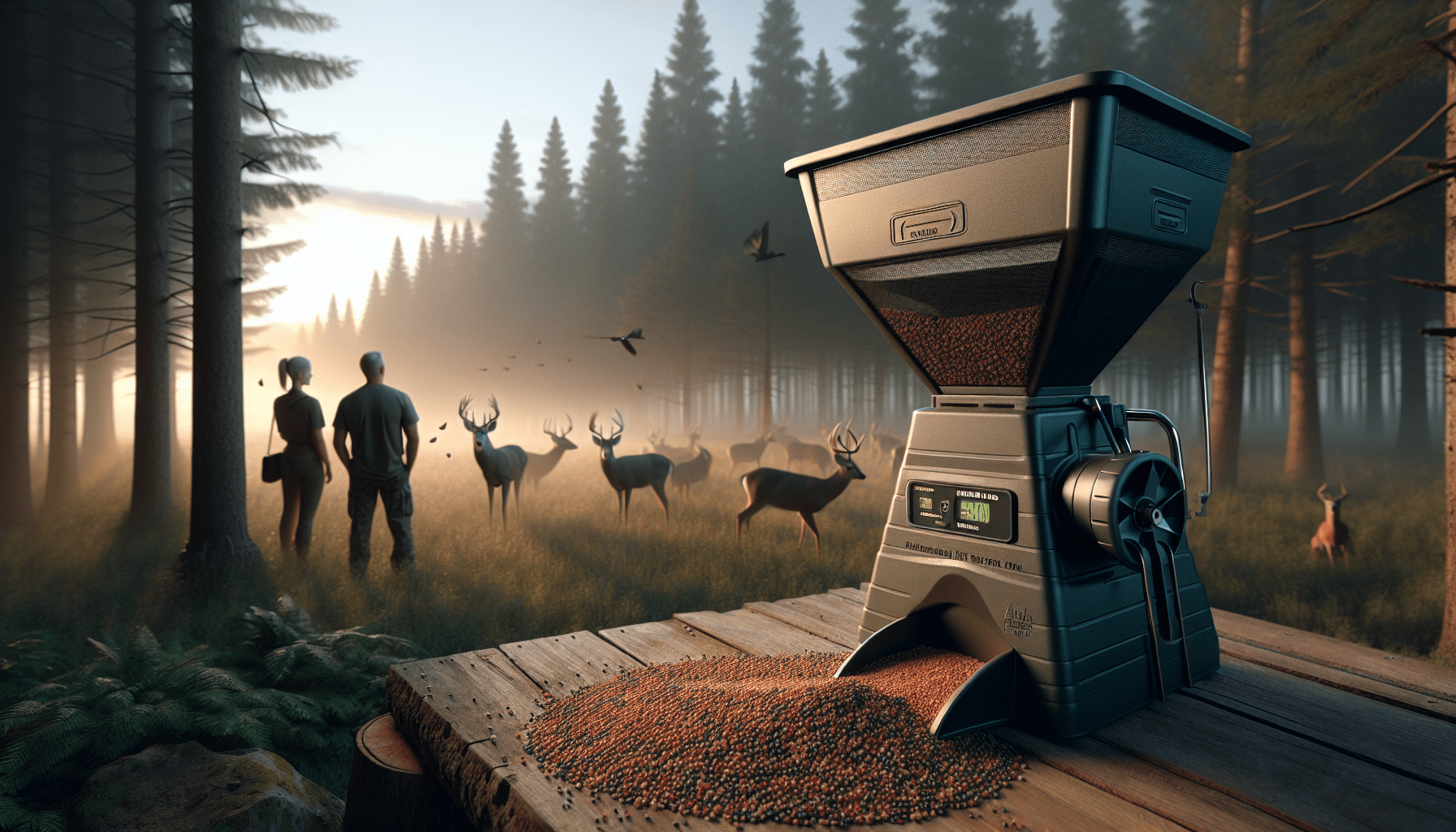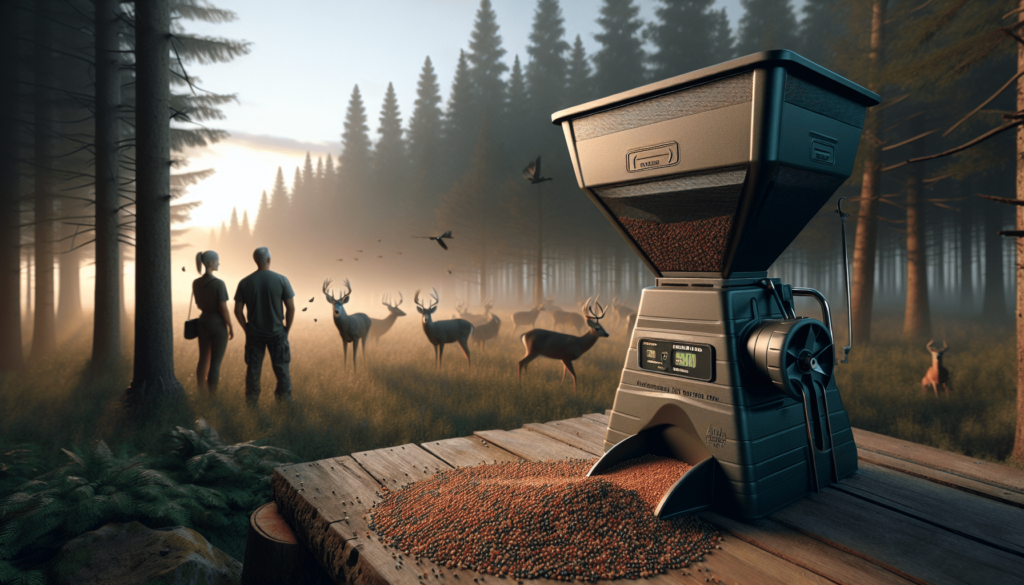
In the world of deer feeding, finding the right automatic feeder can be a challenge, which is why you’ve found yourself here. This article is all about navigating the sea of choices and equipping you with the knowledge to pinpoint the perfect feeder for your needs. From understanding key features to considering different brands like Moultrie, Boss Buck, WILDGAME INNOVATIONS, REDNEK, and Banks Outdoors, you’ll feel confident when you make your final decision. So, buckle up and let’s illuminate the path to choosing the best automatic deer feeder for you.

Understanding Automatic Deer Feeders
Let’s kick things off with understanding what automatic deer feeders are. These useful contraptions are devices that automatically dispense food for deer at regular intervals. They are a popular tool among wildlife observers and hunters alike, aiding in the healthy nurturing and prospective sighting of deer.
Basics of automatic deer feeders
At its most basic level, an automatic deer feeder is made up of a reservoir or barrel to hold the feed, a mechanism to dispense the feed, and a timer to control when the feed is dispensed. Some sophisticated models also come with solar panels for energy efficiency and weatherproof design for durable performance.
How automatic deer feeders work
The working of automatic deer feeders is pretty straightforward. The feed, usually in the form of pellets or corn, is stored in the feeder’s reservoir. When it’s time to dispense the feed, the dispensing mechanism, often a motorized spinning plate or equivalent, is triggered by the timer. This action scatters the feed around the feeder, attracting deer to the area.
Benefits of using automatic deer feeders
Automatic deer feeders bring several benefits to the table. Firstly, they allow you to attract and observe deer in a consistent, manageable way. They also aid in the growth and health of the deer population by providing a steady food source, particularly in areas where natural food may be scarce. Lastly, they also afford convenience, reducing the need for manual feeding and consistent monitoring.
Essential Features of a Good Automatic Deer Feeder
Before you make a purchase, it’s important to know what features to look out for in an automatic deer feeder.
Durability and construction quality
Ensure that the feeder you choose is durable and built to last. It should be designed to withstand harsh weather conditions and potential rough handling by wildlife.
Feeder capacity
The feeder capacity determines how much feed it can hold at a time. Depending on the number of deer you wish to feed and the frequency of refilling you are comfortable with, choose a feeder with appropriate capacity.
Dispensing mechanism
Agricultural systems may vary in their dispensing mechanisms. Some use a spinning plate to scatter feed, while others drop feed straight down. The option you choose should be able to distribute the feed as evenly as possible to prevent competition among deer.
Battery power and solar compatibility
Most automatic deer feeders run on battery power, and having a solar panel can help conserve battery life. In areas with ample sunlight, a solar-compatible feeder can be a cost-efficient and eco-friendly option.
Weather resistance
Wildlife feeders should be designed to resist various weather conditions, from scorching sun to heavy snow, to ensure uninterrupted operation.
Examining Brand-specific Features
Different brands bring unique features to their deer feeder products. Here are some popular brands you may consider.
Unique features in Moultrie deer feeders
Moultrie offers deer feeders with an array of features such as digital timers, adjustable feed times, and durable UV-resistant plastic constructions. They are also known for their user-friendly design and reliable performance.
What sets Boss Buck feeders apart
Boss Buck feeders are revered for their rugged, all-weather resistance and large feeding capacity. They also boast gravity-fed systems that maintain a consistent supply of deer feed without the need for timers or batteries.
Key offerings in WILDGAME INNOVATIONS deer feeders
WILDGAME INNOVATIONS specialize in high-tech deer feeders. They feature digital timers for precise feeding schedules, spin plate for even distribution, and solar-panel compatibility for efficient energy use.
An overview of REDNEK Deer Feeder features
REDNEK are said to excel when it comes to simplicity and durability. Their feeders encompass a sturdy metal construction and easy-to-use mechanism, making them a popular choice among many users.
Banks Outdoors Deer Feeder unique characteristics
Banks Outdoors feeders stand out with their gravity-fed system and UV-stabilized polyethylene design. They’re also known for the watertight design that prevents moisture from spoiling the feed.
Choosing Based on Types of Automatic Deer Feeders
When it comes to choosing an automatic deer feeder, you may want to consider the type based on its feeding mechanism.
Gravity feeders: Pros and cons
Gravity feeders are a simple and low-maintenance option. They dispense automatically as deer eat, keeping the supply of food constant without the use of timers or batteries. However, it’s essential to note that they may be difficult to control the amount of feed consumed and can attract unwanted critters.
Electronic feeders: Benefits and drawbacks
Electronic feeders give more control over feeding schedules and quantities but require batteries and routine maintenance. They can prevent overeating and limit interaction among deer. However, their reliance on batteries may present a challenge in remote locations.
Considerations for Setting Up an Automatic Deer Feeder
Choosing the right location and setup for your feeder can determine your success.
Ideal locations for deer feeders
Pick a location where deer naturally frequent. It should be quiet, secluded, and close to cover such as bushes or trees. But, ensure it’s accessible for you to refill and maintain the feeder.
Possible threats to deer feeders
Potential threats include predators, invasive species like rodents or birds, and harsh weather conditions. Choosing a feeder with sturdy construction and critter-proof features can help mitigate these issues.
Best practices for setting up deer feeders
When setting up, ensure the feeder is firmly anchored to prevent it from being knocked over. It should also be placed at a height that is accessible to deer but not to smaller creatures. Monitoring the feeder regularly to ensure it functions correctly and is adequately stocked is also crucial.
How to Maintain Automatic Deer Feeders
Regular maintenance of your feeder is key to its longevity and effectiveness.
Routine inspection and cleaning
Routine inspection and cleaning will help keep your feeder in the best shape. Check for any damage or blockages and clean feeders regularly to prevent mold and bacterial growth.
Battery maintenance
For electronic feeders, keeping track of the battery life is also integral. Regularly check the battery and replace or recharge it as needed.
Addressing common feeder issues
Common problems such as blocked feeding tubes, malfunctioning timers, or drained batteries should be addressed promptly to prevent interruption to the feeding schedule.
Important Factors in Deer Attraction
Attracting deer is about more than just providing food. Here are some additional considerations.
Choosing the right feed
The type of feed can significantly influence deer attraction. Corn, soybeans, and specially formulated deer pellets are popular choices.
Timing the feeder
The timing of feeds can also attract deer. Adjust the timers on your feeder according to when deer are most active, typically dawn and dusk.
Adding attraction enhancers
In addition to the regular feed, attraction enhancers such as salt licks, deer blocks, or scents can further attract deer to your feeder.
Understanding Local Regulations and Ethical Aspects
Feeding deer is regulated in many places due to its potential impact on wildlife and the environment.
Local laws on feeding wildlife
Before setting up a feeder, check local laws on feeding wildlife. In some areas, it may be illegal or limited to certain times of the year.
Responsible feeding practices
Feeding should be done responsibly to avoid negative impacts on the deer and their natural habits. Too much feeding or feeding the wrong types of food can be harmful to deer.
Balancing deer attraction and ecological impact
While attracting deer, also consider the impact on the local ecosystem. Overfeeding can lead to overpopulation and imbalance in the ecosystem. It’s important to strike a balance between attracting deer and preserving the environment.
Budget Considerations for Buying an Automatic Deer Feeder
Like any purchase, budget considerations are important when buying an automatic deer feeder.
Deciding on a budget
Set a budget based on how much you are willing to spend and the key features you require.
Understanding the cost vs. quality trade-off
While lower-priced feeders may seem attractive, they may lack durability, capacity, or other essential features. Higher-priced feeders may offer more features, reliability, and longevity.
Reviewing various price ranges of popular brands
Review and compare prices of different brands at different price points, from low to high. This will give you a better understanding of what you can expect for your budget.
Where to Buy Automatic Deer Feeders
Once you’ve made your choice, it’s time to buy your feeder.
Buying direct from brand websites
Purchasing directly from the manufacturer’s website often guarantees that you are buying a genuine product, and they might also offer warranties.
Exploring local sporting goods stores
Local stores like hunting or outdoor sporting goods shops often stock various feeders from popular brands. This also gives you the advantage to check the feeder physically before buying.
Online marketplaces and hunting gear sites
Online marketplaces like Amazon and specialized hunting gear websites can offer a wide range of deer feeders for you to choose from. Be sure to check customer reviews and ratings before making a purchase.
Evaluating vendor credibility and customer reviews
Regardless of where you purchase, always check the credibility of the vendor and reviews from previous customers to get a sense of product quality and customer service.
In summary, getting the best automatic deer feeder depends on your specific needs, location, deer behavior, and budget. With the above information, you’re well-equipped to make an informed decision. Happy deer watching!



